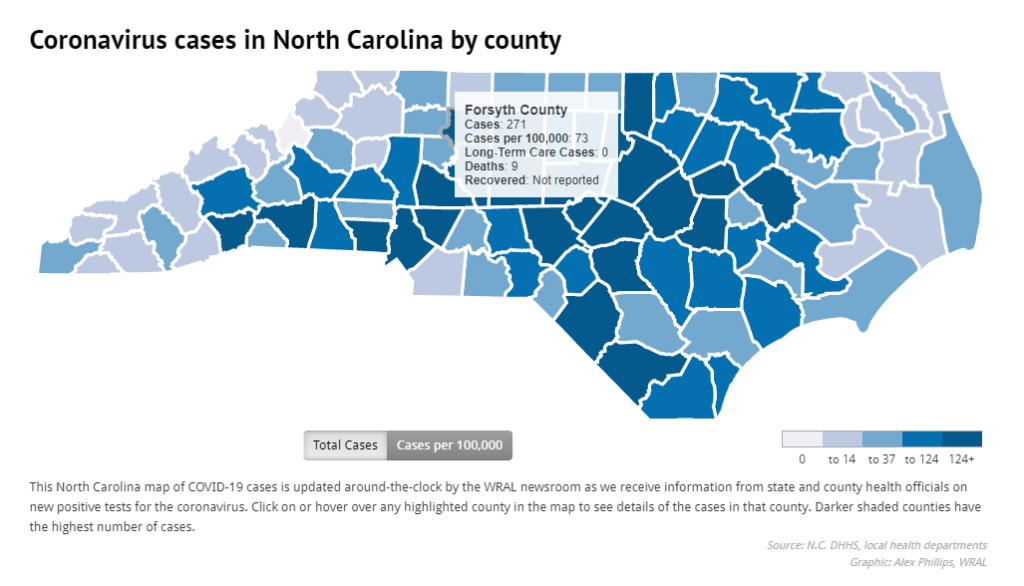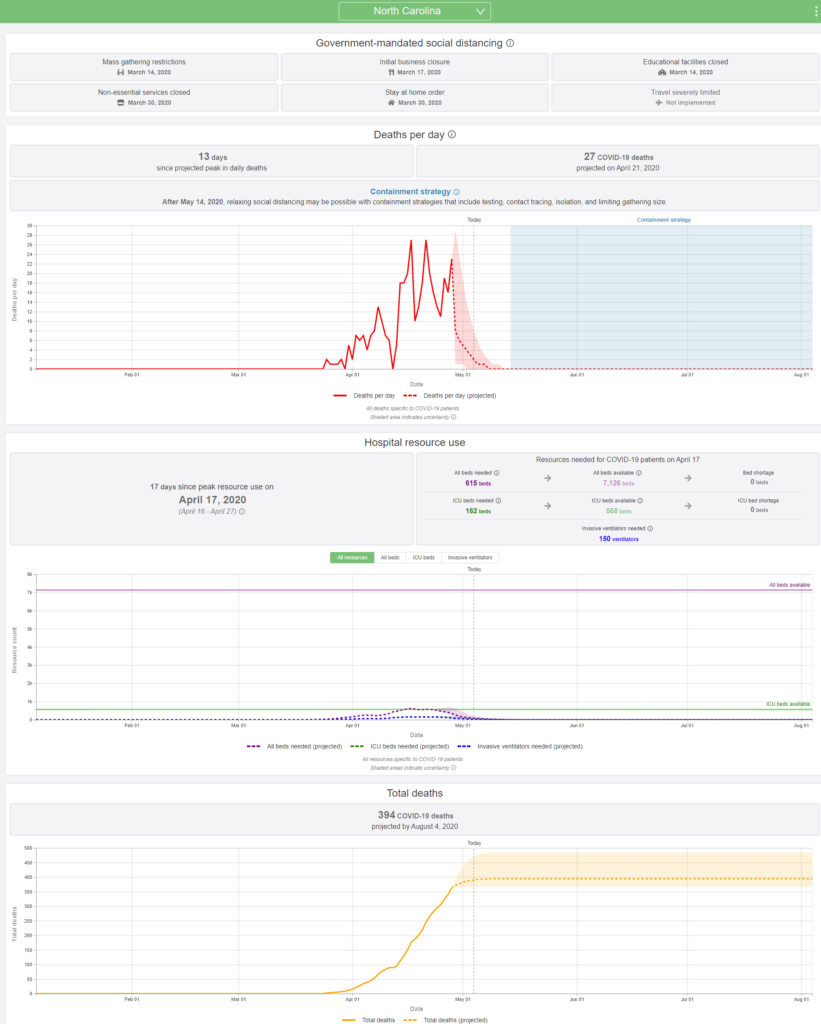World:

US:


NC and local:



For a while there, I was beginning to think that opening up a few states might be in the cards. Apparently even the Trump Administration disagrees (even though they are advocating opening up themselves.

As President Trump presses for states to reopen their economies, his administration is privately projecting a steady rise in the number of cases and deaths from the coronavirus over the next several weeks, reaching about 3,000 daily deaths on June 1, according to an internal document obtained by The New York Times, nearly double from the current level of about 1,750.
The projections, based on government modeling pulled together in chart form by the Federal Emergency Management Agency, forecast about 200,000 new cases each day by the end of the month, up from about 25,000 cases now.
The numbers underscore a sobering reality: While the United States has been hunkered down for the past seven weeks, significant risks remain. And the reopening to the economy will make matters worse.
Here’s the internal report:
WH response through Deputy Press Secretary:
This is not a White House document nor has it been presented to the task force or gone through interagency vetting. This data is not reflective of any of the modeling done by the Coronavirus Task Force or data that the task force has analyzed. #COVID19 https://t.co/mTK0724Mzp
— Judd Deere (@JuddPDeere45) May 4, 2020
We should remember the White House’s history in “vetting” COVID-19 models. It originally used models by economist Kevin Hassett, who insisted COVID-19 wasn’t a big deal. And thus, we had inadequate PPE and othe medical supplies.
The data from recent days is not comforting:
States that saw a week-over-week increase in #COVID19 cases:
— Reid Wilson (@PoliticsReid) May 4, 2020
AK
AZ
DC
GA
IL
IN
IA
KS
KY
ME
MD
MN
MS
MO
NE
NH
NM
NC
ND
OK
SC
TN
TX
VT
VA
WA
WI
WY
This Washington Post piece picks up where the earlier White House tick-tocks of the first two months left off. They didn’t get better. They got worse:
The epidemiological models under review in the White House Situation Room in late March were bracing. In a best-case scenario, they showed the novel coronavirus was likely to kill between 100,000 and 240,000 Americans. President Trump was apprehensive about so much carnage on his watch, yet also impatient to reopen the economy — and he wanted data to justify doing so.
So the White House considered its own analysis. A small team led by Kevin Hassett — a former chairman of Trump’s Council of Economic Advisers with no background in infectious diseases — quietly built an econometric model to guide response operations.
Many White House aides interpreted the analysis as predicting that the daily death count would peak in mid-April before dropping off substantially, and that there would be far fewer fatalities than initially foreseen, according to six people briefed on it.
Although Hassett denied that he ever projected the number of dead, other senior administration officials said his presentations characterized the count as lower than commonly forecast — and that it was embraced inside the West Wing by the president’s son-in-law, Jared Kushner, and other powerful aides helping to oversee the government’s pandemic response. It affirmed their own skepticism about the severity of the virus and bolstered their case to shift the focus to the economy, which they firmly believed would determine whether Trump wins a second term.
For Trump — whose decision-making has been guided largely by his reelection prospects — the analysis, coupled with Hassett’s grim predictions of economic calamity, provided justification to pivot to where he preferred to be: cheering an economic revival rather than managing a catastrophic health crisis.
Trump directed his coronavirus task force to issue guidelines for reopening businesses, encouraged “LIBERATE” protests to apply pressure on governors and proclaimed that “the cure can’t be worse than the problem itself” — even as polls showed that Americans were far more concerned about their personal safety.
By the end of April — with more Americans dying in the month than in all of the Vietnam War — it became clear that the Hassett model was too good to be true. “A catastrophic miss,” as a former senior administration official briefed on the data described it. The president’s course would not be changed, however. Trump and Kushner began to declare a great victory against the virus, while urging America to start reopening businesses and schools.
“It’s going to go. It’s going to leave. It’s going to be gone. It’s going to be eradicated,” the president said Wednesday, hours after his son-in-law claimed the administration’s response had been “a great success story.”
The span of 34 days between March 29, when Trump agreed to extend strict social-distancing guidelines, and this past week, when he celebrated the reopening of some states as a harbinger of economic revival, tells a story of desperation and dysfunction.
The story goes on to show one of the most bone-chilling behind the scenes view of a series of decisions affecting the lives of American citizens I’ve ever read. Literally being a foreign agent working for an enemy could not be worse.
We already knew that January and February were lost months as Trump lived in denial and dithered about doing anything. Now we know that March and April they actually worked to sabotage the response. Trump asked for rosy scenarios and he and the Jared cabal used them to justify their foot-dragging and happy talk.
They knew. They lied. And all because Trump and Jared didn’t know what to do so they decided that the only way to get re-elected was to pretend it wasn’t happening.
It is stunning.
For the 5th time in two weeks, Trump tweaks projected death toll.
Now, we’re going toward 50, I’m hearing, or 60,000 people. One is too many. I always say it: One is too many. But we’re going toward 50- or 60,000 people. That’s at the lower — as you know, the low number was supposed to be 100,000 people. We — we could end up at 50 to 60. Okay? It’s horrible.
A week later the lower bound was 60,000. (“[W]e’re probably heading to 60,000, 70,000.”) This past Wednesday it was 65,000.
“If we lose 65,000 people” — Trump has moved the goalposts from no deaths to fewer deaths than the Swine Flu to 60,000 deaths & now to 65,000 or 70,000 deaths.
He’s positioned himself to proclaim any death toll smaller than 2 million Americans as a reflection of his good work. pic.twitter.com/y0pOhf3iEE
— Aaron Rupar (@atrupar) April 29, 2020
If you lose 65,000 people — it’s so crazy to say it, it’s just so horrible — but if we lose 65,000 people, and instead of that, going the other route, we would have lost a million or a million and a half or 2 million — it’s possible, it’s possible that you lost more — but could you imagine?
Last night he gave two numbers. First it was 80,000 or 90,000, although that appears to be a prediction rather than a lower bound:
“I used to say 65,000,” the president said, pointing to a total he promoted just a few days earlier. “And now I’m saying 80,000 or 90,000.”
Then it was even more, in the same town hall:
“Look, we’re going to lose anywhere from 75, 80 to 100,000 people. That’s a horrible thing. We shouldn’t lose one person out of this,” Trump said speaking during a Fox News virtual town hall.
Let’s give him credit for only one tweak, since this was the same night: 75,000 as a lower bound and 100,000 as an upper. That’s four tweaks.
No figure that is not six digits is remotely plausible, and I continue to think the death toll will be in the hundreds of thousands. We’ve lost nearly 70,000 people with barely over a million cases — and 100 million people could easily get this disease in this country before we are done.
